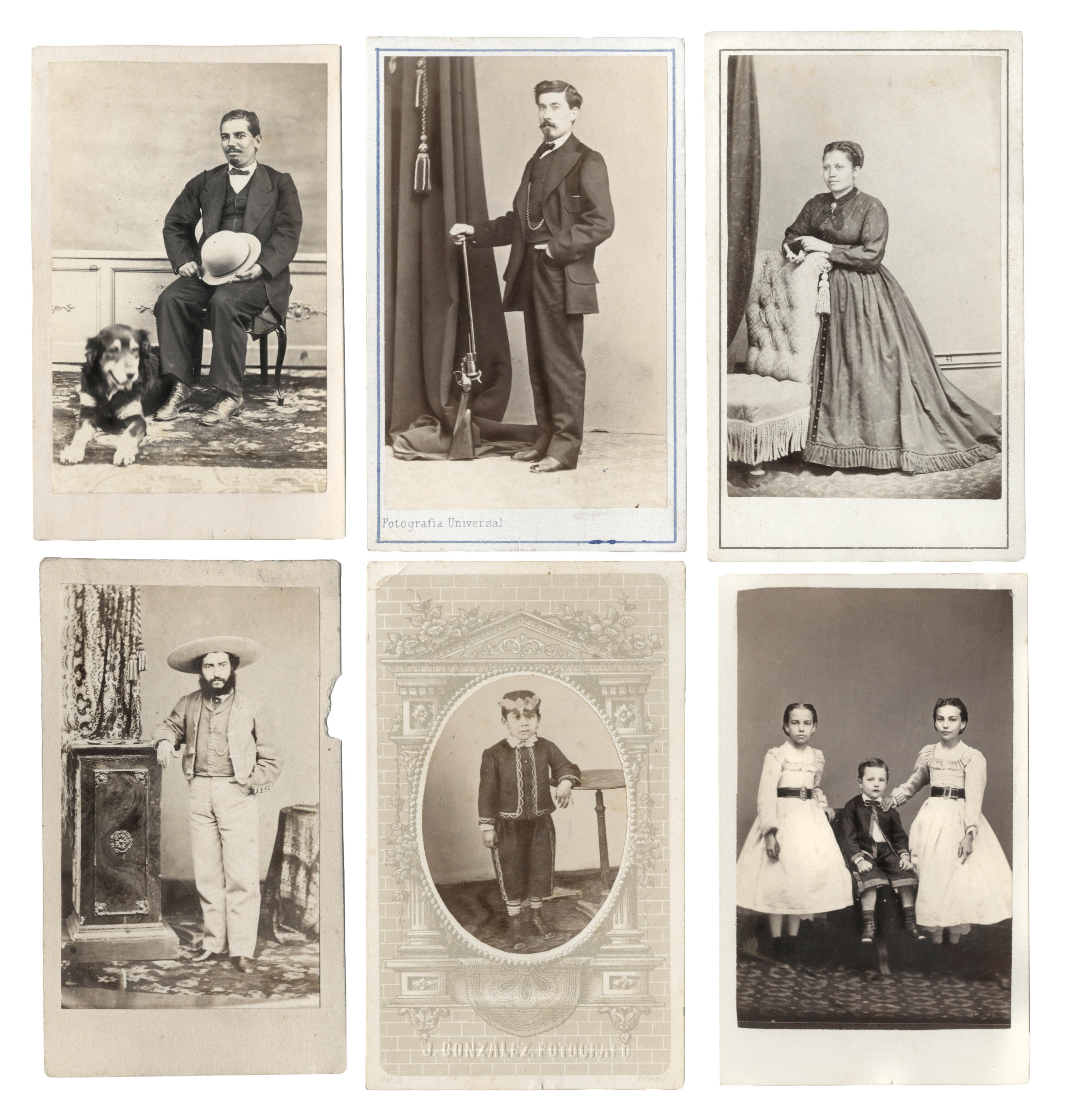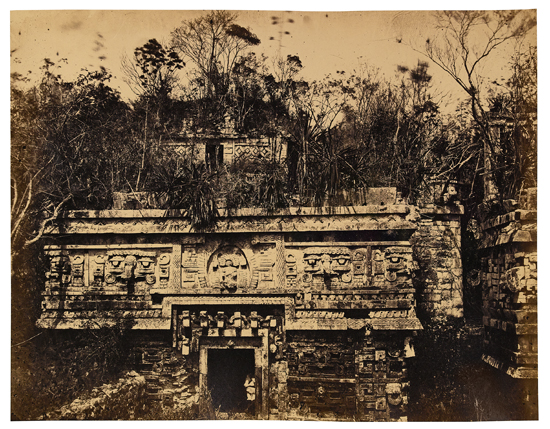Contemporary album of twenty-two large, albumen photographs depicting the aftermath of the Siege of Puebla taken by a member of the French expedition.
Puebla, Mexico, 1863]. Each photograph measuring approximately 10x8 inches, mounted in an oblong folio album and with a contemporary caption identifying the location. With a printed plan of Puebla and a manuscript tracing of a similar plan (the latter laid in). Provenance : Baron Berge (bookplate). among the earliest examples of wartime documentary photography and likely the only album depicting the french intervention of mexico in private hands. This massive volume of magnificent photographs, taken by a photographer connected with the invading army, depict the aftermath of the French siege of Puebla in May of 1863, a pivotal moment during the 1861-1867 French intervention in Mexico. The images show the battle-torn ruins of Puebla, including forts, battlements, churches, convents, the penitentiary, and general vistas of the city. Detailed pencil captions in French describe the location and subjects of each photograph, and at times even cite the particular unit and commander that caused the damage depicted in the photograph. The album was likely assembled for Baron Berge, whose bookplate is attached to the front pastedown, and who was also almost certainly an officer of the invading French army. Original photographs of Mexican warfare from this period are very rare. Earlier wartime images, including daguerreotypes made during the Mexican War, were almost entirely limited to portraits of soldiers. Several recent histories of Mexican photography (e.g. Ochoa, La Fotografia Durante El Imperio De Maximiliano and Debroise, Fuga Mexicana. Un Recorrido por la Fotografia en Mexico ) treat the development of photography after Maximilian's arrival in 1864, but fail to detail the existence of a significant photographic record of the actual intervention period of 1862-63. Ochoa mentions a few surviving images in European archives, but the lack of reproduced examples underscores the rarity of such images (see Ochoa, p.17). At the time these images of Puebla were made, photography was only beginning to be used as a documentary tool in the battlefield. The Crimean War (1853-56), was the first to be photographically documented in an extensive manner. In America, Gardner, Barnard, and other Civil War photographers made further advancements in battlefield photography. The present images rank in importance with these pioneers in the history of wartime photographs. The captioned photographs are as follows: 1) Puebla. Le fort de Guadalupe et le fort de Loreto...Le fort de Guadalupe est dans l'état de d'efense adopté à la suite de l'attaque du 5 Mai 1862. 2) Puebla. La ville et le paséo viejo vus de la descente de Guadalupe, face au midi. 3) Puebla la ville et la cathédrale vues du chemin qui descend des hauteurs de Guadalupe et de Loreto entre les deux forts. L'arsenal à gauche de la cathédrale, établi dans l'église de la compañia. 4) Puebla. La ville vue du chemin qui descend de Loreto[.] En vue le penitencier, Saint Xavier, Santo Domingo. 5) Puebla. Vue de Saint Xavier et du penitencier prise du paseo nuevo. A droite la place comprise entre St. Xavier et la pensionnat de Guadalupita.... 6) Puebla. Le penitencier, vue prise de la route de Mexico face à l'Est. La bréche [sic], faite à la façade centrale, est faite par la batterie no. 9, Capitaine Pachon. A droite la bastion auquel est donné l'assaut, le 29 Mars à 5h du soir. 7) Puebla. Penitencier, façade sud, au moment de l'assaut du 29 Mars, à 5h du soir. Cette façade était battue par las batteries no. 3 (Philibere), no. 4 (de Vasins), no. 5 (Deléval [Delévat?]), no. 6. (D'Huart), no. 8 (Guinard).... 8) Puebla. La maison du bains [baies?] enlevée dans la nuit du 28 au 29 Mars sous la direction de M. le Cnel. Mougin....Au fond, au dessus de la maison, le cerro San Juan, quartier général du Général Forey. 9) Puebla. Le fort de Totimehuacan, bastion Sud Est, bastion d'attaque.... 10) Puebla. Convent et fort de Carmen; façades Sud et ouest.... 11) Puebla. Fort de Guadalupe, vu du chemin qui vient de
Contemporary album of twenty-two large, albumen photographs depicting the aftermath of the Siege of Puebla taken by a member of the French expedition.
Puebla, Mexico, 1863]. Each photograph measuring approximately 10x8 inches, mounted in an oblong folio album and with a contemporary caption identifying the location. With a printed plan of Puebla and a manuscript tracing of a similar plan (the latter laid in). Provenance : Baron Berge (bookplate). among the earliest examples of wartime documentary photography and likely the only album depicting the french intervention of mexico in private hands. This massive volume of magnificent photographs, taken by a photographer connected with the invading army, depict the aftermath of the French siege of Puebla in May of 1863, a pivotal moment during the 1861-1867 French intervention in Mexico. The images show the battle-torn ruins of Puebla, including forts, battlements, churches, convents, the penitentiary, and general vistas of the city. Detailed pencil captions in French describe the location and subjects of each photograph, and at times even cite the particular unit and commander that caused the damage depicted in the photograph. The album was likely assembled for Baron Berge, whose bookplate is attached to the front pastedown, and who was also almost certainly an officer of the invading French army. Original photographs of Mexican warfare from this period are very rare. Earlier wartime images, including daguerreotypes made during the Mexican War, were almost entirely limited to portraits of soldiers. Several recent histories of Mexican photography (e.g. Ochoa, La Fotografia Durante El Imperio De Maximiliano and Debroise, Fuga Mexicana. Un Recorrido por la Fotografia en Mexico ) treat the development of photography after Maximilian's arrival in 1864, but fail to detail the existence of a significant photographic record of the actual intervention period of 1862-63. Ochoa mentions a few surviving images in European archives, but the lack of reproduced examples underscores the rarity of such images (see Ochoa, p.17). At the time these images of Puebla were made, photography was only beginning to be used as a documentary tool in the battlefield. The Crimean War (1853-56), was the first to be photographically documented in an extensive manner. In America, Gardner, Barnard, and other Civil War photographers made further advancements in battlefield photography. The present images rank in importance with these pioneers in the history of wartime photographs. The captioned photographs are as follows: 1) Puebla. Le fort de Guadalupe et le fort de Loreto...Le fort de Guadalupe est dans l'état de d'efense adopté à la suite de l'attaque du 5 Mai 1862. 2) Puebla. La ville et le paséo viejo vus de la descente de Guadalupe, face au midi. 3) Puebla la ville et la cathédrale vues du chemin qui descend des hauteurs de Guadalupe et de Loreto entre les deux forts. L'arsenal à gauche de la cathédrale, établi dans l'église de la compañia. 4) Puebla. La ville vue du chemin qui descend de Loreto[.] En vue le penitencier, Saint Xavier, Santo Domingo. 5) Puebla. Vue de Saint Xavier et du penitencier prise du paseo nuevo. A droite la place comprise entre St. Xavier et la pensionnat de Guadalupita.... 6) Puebla. Le penitencier, vue prise de la route de Mexico face à l'Est. La bréche [sic], faite à la façade centrale, est faite par la batterie no. 9, Capitaine Pachon. A droite la bastion auquel est donné l'assaut, le 29 Mars à 5h du soir. 7) Puebla. Penitencier, façade sud, au moment de l'assaut du 29 Mars, à 5h du soir. Cette façade était battue par las batteries no. 3 (Philibere), no. 4 (de Vasins), no. 5 (Deléval [Delévat?]), no. 6. (D'Huart), no. 8 (Guinard).... 8) Puebla. La maison du bains [baies?] enlevée dans la nuit du 28 au 29 Mars sous la direction de M. le Cnel. Mougin....Au fond, au dessus de la maison, le cerro San Juan, quartier général du Général Forey. 9) Puebla. Le fort de Totimehuacan, bastion Sud Est, bastion d'attaque.... 10) Puebla. Convent et fort de Carmen; façades Sud et ouest.... 11) Puebla. Fort de Guadalupe, vu du chemin qui vient de


.jpg)




.jpg)


.jpg)




Testen Sie LotSearch und seine Premium-Features 7 Tage - ohne Kosten!
Lassen Sie sich automatisch über neue Objekte in kommenden Auktionen benachrichtigen.
Suchauftrag anlegen